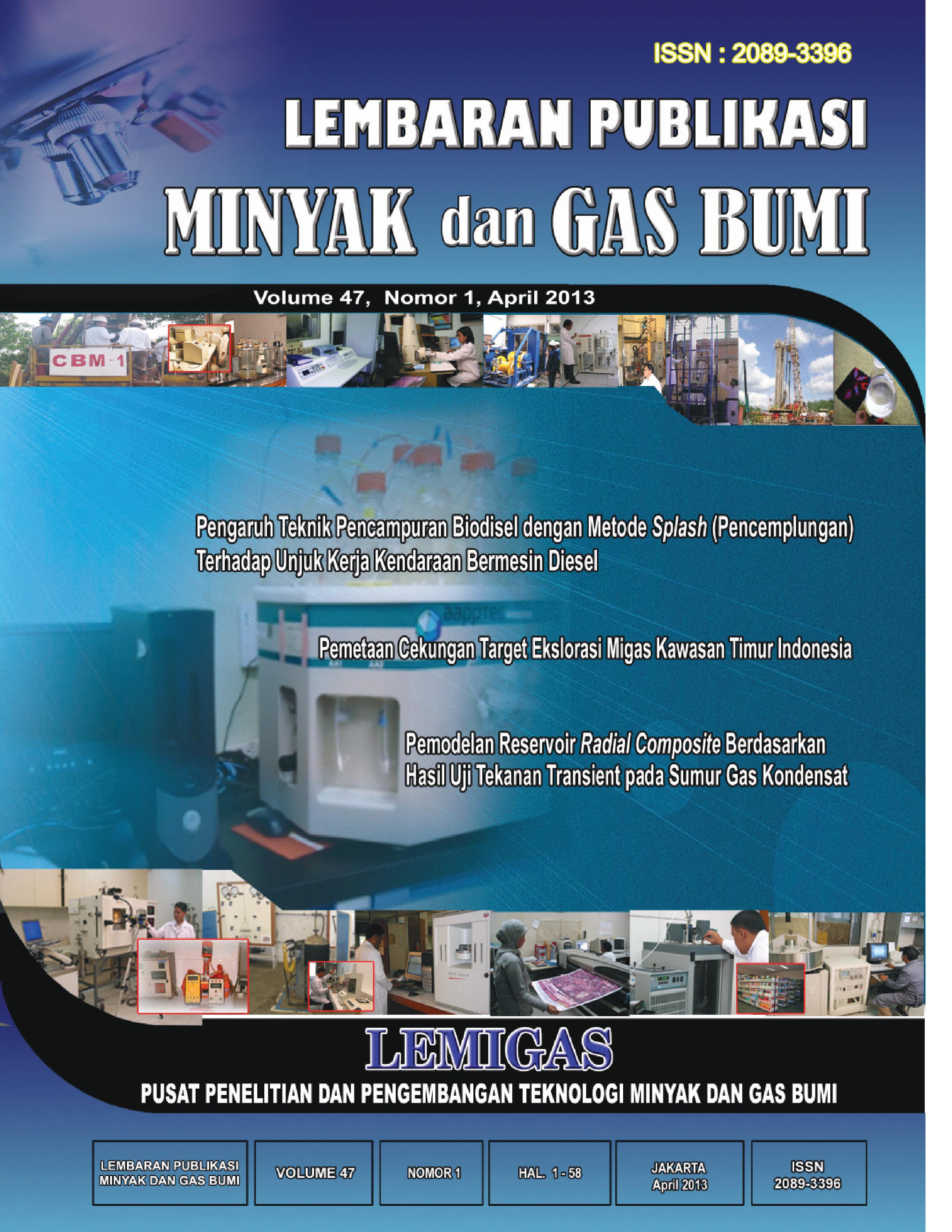Simulasi Distribusi Titik Didih Distilasi TBP dan Hempel Menggunakan Model Matematika Riazy
DOI:
https://doi.org/10.29017/LPMGB.47.1.221Kata Kunci:
Distilasi TBP, Hempel, simulasi, model matematik, titik didihAbstrak
Data Distilasi TBP dan Hempel merupakan data yang sangat penting karena digunakan sebagai data desain dan pengembangan produk di kilang. Namun Distilasi TBP membutuhkan biaya mahal dan waktu lama di laboratorium. Kurva distilasi TBP dan Hempel dapat diprediksi secara lengkap dan akurat, menggunakan Persamaan Riazy, dengan hanya menggunakan data pada tekanan atmosfir sampai suhu 180oC pada distilasi TBP dan suhu sampai 175oC untuk distilasi Hempel, pada minyak bumi seperti Duri, SLC, Sepinggan, Attaka, Westseno, Arjuna dan Camar. Tingkat korelasi (R2) persamaan Riazy untuk distilasi TBP dan Hempel diatas 0.990 dan deviasi rerata antara 0.7 %- 7.5%, kecuali untuk TBP minyak duri dengan R2 = 0.970 dan deviasi rerata 42%. Deviasi relatif besar terjadi pada prediksi suhu pada tekanan vakum, karena meningkatnya kecepatan uap sehingga terjadi penurunan tekanan antara tekanan dasar kolom dengan puncak kolom, serta adanya faktor konversi suhu pada tekanan vakum ke suhu tekanan atmosfir menggunakan persamaan Maxwell dan Bonnel. Tingkat korelasi simulasi dapat ditingkatkan dengan menggunakan data pemotongan suhu sempit ( 20-25oC). Durasi distilasi TBP dapat dipersingkat, dari 48 jam menjadi sekitar 2 jam dan dari 7-8 jam menjadi 30-40 menit untuk distilasi Hempel.
TBP and Hempel distillation curve are very important data for any crude oil for modeling in refinery distillation column. However, TBP analysis is expensive and time consuming. A full-range TBP and Hempel distillation curve can be generated from an incomplete distillation data by Riazy equation. Simulation of TBP and Hempel distillation on Riazy equation, using distillation data up to 180oC for TBP distillation and up to 175oC for Hempel distillation at atmospheric pressure, can predict with high accuracy a full range distillation data on different characteristics of Indonesian crude oil such as Duri, Minas/SLC, Sepinggan, Attaka, Westseno, Arjuna and Camar. Degree of correlation (R2) riazy equation for simulation of TBP and Hempel distillation 0.990. and the average deviation in the range of 0.7% - 7.5%, except for simulation of Duri TBP distillation with R2=0.970 and the average deviation of 42%. A large deviations occur in the predicted temperature at vacuum pressure, due to the increased of vapor velocity that resulting a large pressure drop between the bottom of column and the top of the column, and also the use of Maxwell's and Bonnel Equation for temperature conversion on vacuum pressure to atmospheric pressure. Degree of Correlation can be improved by using narrow cut temperature of 20-25oC. Crude TBP curve can be generated in about 2 hours instead of the 48 hours and about 40 minutes instead of 7-8 hours for Hempel distillation .
Referensi
Annual Book of ASTM Standar , Vol.05.01.,2009. ASTM D 1160 -06, “Standard Test method for petroleum product at Reduced pressure distilation ”, USA : ASTM International.
Annual Book of ASTM Standar , Vol.05.01.,2009. ASTM D 2892 -05, “Standard Test Method for Distillation of Crude Petroleum (15-Theoretical Plate Column)., ASTM International.
Montemayor, Rey G. ,2008, Distillation and Vapor Pressure Measurement in Petroleum Product, ASTM International.,Philadelpia
Nedelchev, A., Stratiev, D., Ivanov, A., and Stoilov, G, 2011, It's possible to derive TBP from partial distillation data, Oil and Gas Journal, Vol. 109,Texas.
Nedelchev, A., Stratiev, D., Ivanov, A., and Stoilov, 2011, Boiling point distribution of crude oils based on TBP and ASTM D-86 distillation data, Journal of Petroleum & Coal, vol. 53 , p 275-290.
Riazy, M., 1997, A Continuous Model for C7+ Fraction Characterization of Petroleum Fluids," Ind. Eng. Chem. Res., 36 No. 10, pp. 4,299-4,307.
Riazy, M.R., 2005, Characterization and Properties of Petroleum Fractions. Philadelphia: American Society for Testing and Materials,1st ed.











